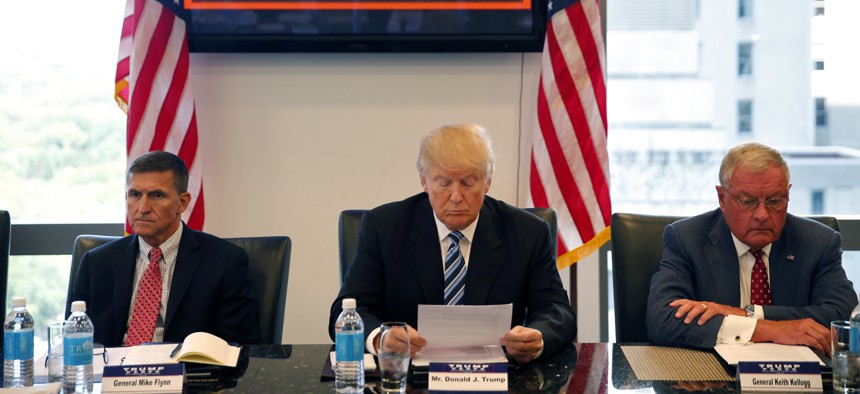
Donald Trump received his first classified intelligence briefing Wednesday. He also held a national security roundtable at Trump Towers with retired Lt. Gen. Mike Flynn, left, and Ret. Army Lt. Gen. Keith Kellogg, right, Wed. Aug. 17, 2016. AP Photo/Gerald Herbert
Trump is Wrong About the Intelligence Community
Presidential candidates should refrain from uninformed and baseless claims that only undermine intelligence professionals.
At a time when threat levels around the world are at an all-time high, statements that the next president should not trust or use the intelligence community are not just counter-productive and reckless, they are downright dangerous.
The IC has been the tip of America's spear for decades. Selfless men and women have put their lives on the line — often doing work their families are unaware of — to keep us safe, and they have. Yes, there have been some tragic failures, but far more impressive successes.
Most of our country’s intelligence successes will never see the light of day, and it is impossible to prove a negative. Our “wins” are secret in order to be effective and so that ongoing operations, the sources supplying key information, and our methods for achieving important missions aren’t compromised.
But here are three major success stories we can point to, the most obvious in recent years being the operation that killed Osama bin Laden. With a direct order from President Obama in 2009 to double down on the search for the leader of al-Qaeda and key funder of the 9/11 attacks, our intelligence community identified a courier who provided bin Laden with his only access to the outside world and who visited the man in his secret compound in Pakistan. Armed with this information, our special operations forces created a mission to capture or kill bin Laden, carried out on May 2, 2011.
As a mother and grandmother to many residents of New York City, disruption of Najibullah Zazi’s plot to bomb the subway there in 2009 was a major intelligence and law enforcement success. An al-Qaeda recruit, Zazi trained with the group in Pakistan and returned to the U.S. to obtain materials and subsequently build explosives for what could have been a devastating attack. Through a series of intelligence collection efforts, we identified Zazi and his intentions and he was arrested and convicted in the U.S. court system for his terror ambitions.
It is widely reported (but not officially confirmed) that the U.S. was involved in the so-called “Stuxnet” cyber operation, displaying our technological ability to sabotage the centrifuges of Iran’s illicit nuclear program. This required extensive intelligence collection and analysis from the human to the digital realms, and was an important effort in delaying the progress of a dangerous weapons capability.
Related: Defense One's complete coverage of intelligence issues
Related: Ten Years After ODNI, Why Intelligence Needs More People, Money and Trust
Since we can’t openly publicize most successes, it makes the failures seem even worse. And there are a few to choose from: Pearl Harbor, the Bay of Pigs, the 9/11 attacks, and the assessments about Saddam Hussein’s Weapons of Mass Destruction program.
I had personal experience with the last two. Despite strategic warnings from those of us who studied the intentions of terror groups, we missed the worst terror attack on U.S. soil in large part because of bureaucratic stovepipes and as the 9/11 Commission found, “a lack of imagination.” The other occurred at a time when the intelligence community was demoralized and the Bush Administration drove intelligence gathering, rather than the other way around.
I was not misled about Saddam’s WMDs; I believed the intelligence. It was wrong. And I was wrong.
Plus, our intelligence community command structure was based on a 1947 business model. What organization can succeed year after year without any change to its structure or innovation over time?
After those two failures Congress stepped in to reform the old model and installed a Director of National Intelligence to coordinate the entire enterprise. The Intelligence Reform and Terrorism Prevention Act of 2004, of which I was a coauthor, was by no means a perfect law. I always say it’s 50 percent law and 50 percent leadership. But it set up a central command structure across 16 intelligence agencies leveraging and coordinating the strengths of each – much like we do in the military.
I hope both candidates take full measure of the awesome capabilities our nation has, now that they are being briefed, and refrain from uninformed and baseless claims which only serve to undermine the people we count on most.
Jane Harman is director, president and CEO of the Wilson Center. Previously, she served nine terms as Democratic member of the U.S House of Representatives from California’s 36th district and was ranking member of the Intelligence Committee.





